| The sponsors or godparents |
The use of sponsors in Baptism dates back to the days when Christians were persecuted by the Roman Emperor Nero. Parents were often massacred during these persecutions. Thus sponsors were provided to instruct the children in the Christian faith in the event the parents were martyred. The godparent promises to see to it that the child is raised and educated in the Orthodox Christian faith. For this reason, it is important that godparents be chosen not for social reasons, but because they are persons who love God and His Church. Sponsors must be Orthodox Christians in good standing with the Church, otherwise they will not be able to bring up the child in a faith that is not theirs.
The godparents of Sofia are Dmitriy Moundous (on the left) and Lada Alger (holding the baby).
|
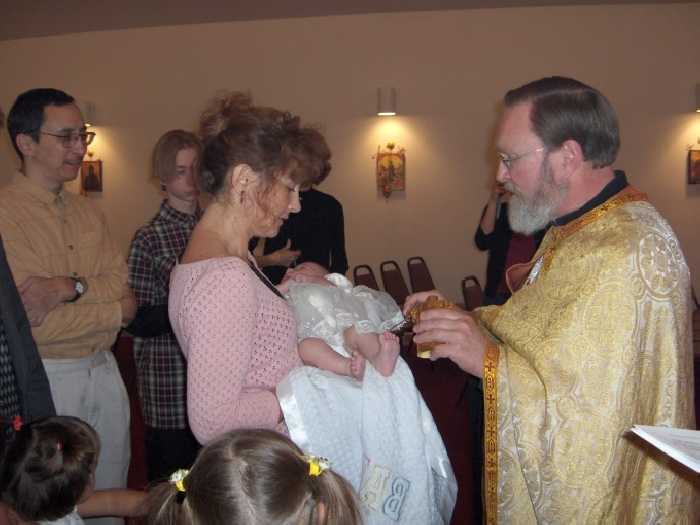 |
| |
|
| Exorcism |
The first act of the Baptismal service begins in the narthex (entrance) of the church. This is to show that the one being received is not yet a member of the Church. The purpose of Baptism is to bring him into the Church. To enter into the temple of God is to be with Christ, to become a member of His body. The Priest then calls upon the sponsor to renounce the devil and all his works on behalf of the child,
"Do you renounce Satan, and all his angels, and all his works, and all his services. and all his pride?"
The exorcisms announce the forthcoming Baptism as an act of victory. The renouncing of Satan is done facing west because the west is where the sun disappears, and was regarded by the ancient Greeks as the place of the gates of Hades. Then the priest faces east whence the light of the sun rises and asks the godparent to accept for the child Him who is the Light of the World
"Do you unite yourself to Christ!"
The renunciation of Satan and the union with Christ express our faith that the newly-baptised child has been transferred from one master to another, from Satan to Christ, from death to life. |
 |
| |
|
| The sign of the cross |
| The priest then makes the sign of the cross on the child's body. This is repeated often during the service. Essentially the cross is the sign of victory which puts the devil to flight. In the old days slaves were branded, as are animals today, to show to what master they belonged. Today the sign of the cross brands us as belonging to Christ. |
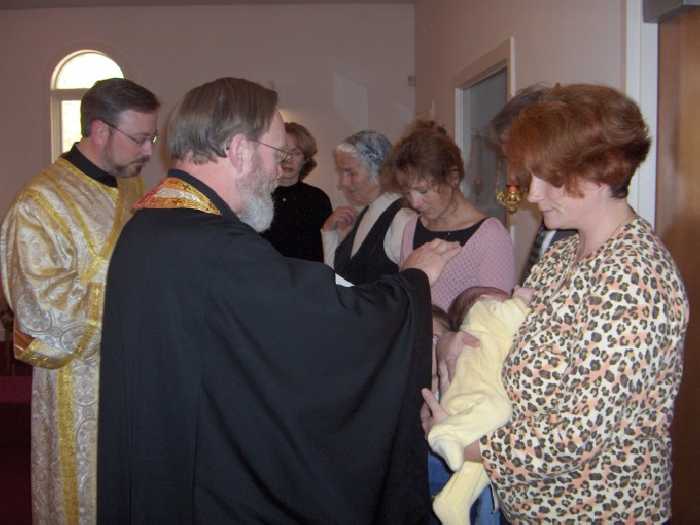 |
| |
|
| The Creed |
| The godparent is then asked to confess faith in Christ in behalf of the infant and reads the confession of faith contained in the Nicene Creed. The Creed was a symbol or sign of recognition among the early Christians; it was like a password that distinguished the true members of God's family. By reading the Creed the godparent confesses the true faith that will be passed on to the infant in time. |
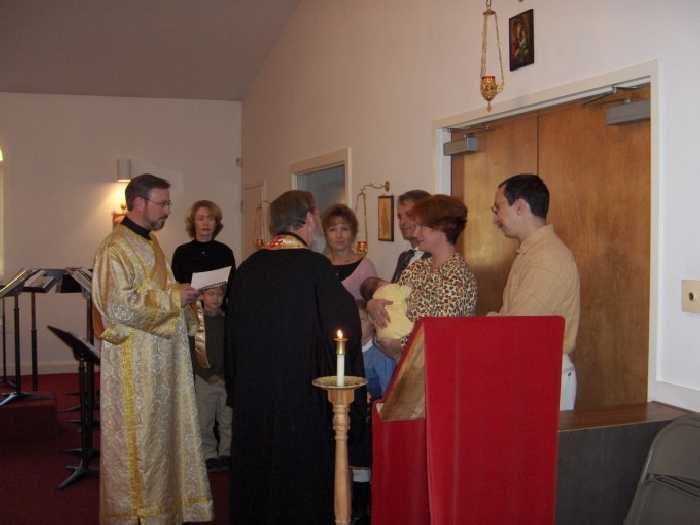 |
| |
|
| The anointing |
| Olive oil is blessed by the Priest and then applied by him to the child's forehead, breast, back, hands, feet, ears, mouth, in order to dedicate them to the service of Christ. The godparent then covers the entire body of the infant with olive oil in order to express our prayer that with Christ's help the infant may be able to elude the grip of sin and the evil one. |
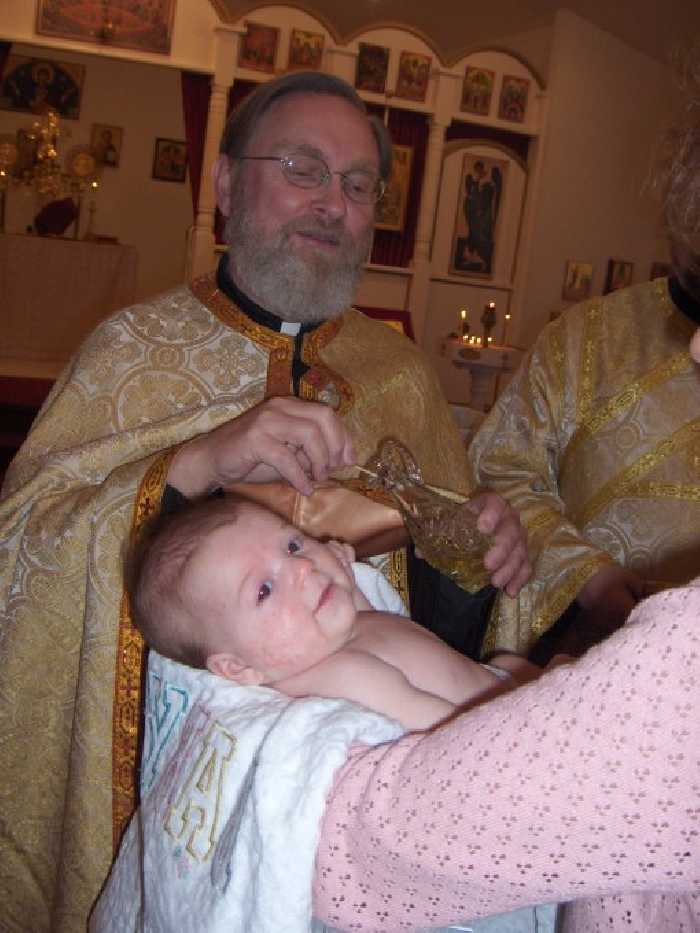 |
| | Anointing
|
| The baptism |
In obedience to Christ’s words, the Priest Baptises the child with the words,
“The servant of God (name) is baptised in the name of the Father. Amen. And of the Son, Amen. And of the Holy Spirit, Amen”.
At each invocation the Priest immerses and then raises the infant up again. After the Baptism the Priest places the child in a new linen sheet held by the Godparent.
|
 |
| | Immersion into the baptismal font
|
| The chrismation |
In the Orthodox Church the Sacrament of Chrismation (known sometimes as Confirmation) is administered immediately following Baptism as in the early Church. It is considered the fulfilment of Baptism. The Priest anoints the newly baptised infant with the Holy Chrism saying,
“the seal of the gift of the Holy Spirit, Amen”.
The whole man is now made the temple of God and the whole body is consecrated to the service of God. According to Orthodox belief every baptised lay person is consecrated by this Sacrament; he receives the gift of the Holy Spirit to become a deputy or an ambassador for Christ in this world. |
 |
| |
|
| New clothes |
Following the Sacrament of Chrismation the Priest then invests the newly Baptised child in a new robe or garment, saying,
“Clothed is the servant of God (name) with the garment of righteousness, in the Name of the Father, and of the Son, and of the Holy Spirit, Amen”.
The new clothes signify the entirely new life that we receive after we are "buried with Jesus in His death" (Romans 6:4). Traditionally, the new white garment expresses the purity of the soul that has been washed from sin. It recalls also the shining robe in which Christ appeared at the Transfiguration. There is now a likeness between the one baptised and the transfigured Lord. St. Paul calls it a putting on of Christ,
"For as many of you as have been baptised in Christ, have put on Christ" (Galatians 3:26-27). "Therefore, if any one is in Christ, he is a newcreation; the old has passed away, behold the new has come" (2 Corinthians 5:17). |
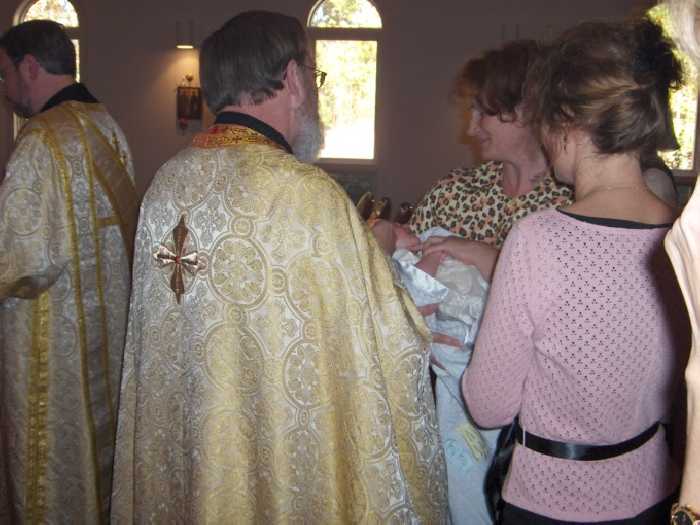 |
| |
|
| The dance |
Then the Priest makes, together with the Godparent and the child, a circumambulation around the Font, three times; and for each of the three rounds the chanters sing,
“As many of you as have been baptised into Christ, have put on Christ. Alleluia” (Galatians 3:27).
This reflects the belief that at this moment the angels in heaven are expressing their joy that a new soul is registered in the Book of Life. Tradition states that at this moment God assigns a guardian angel to stay with the newly-baptised person until the end of their earthly life. Following the reading from St Paul’s Epistle to the Romans (6:3-11) and the Reading from the Holy Gospel (Matt. 28:16-20) the Priest says to the child, “You are baptised; you are illuminated; you are anointed with the Holy Myrrh; you are hallowed; you are washed clean, in the Name of the Father, and of the Son, and of the Holy Spirit. Amen”. |
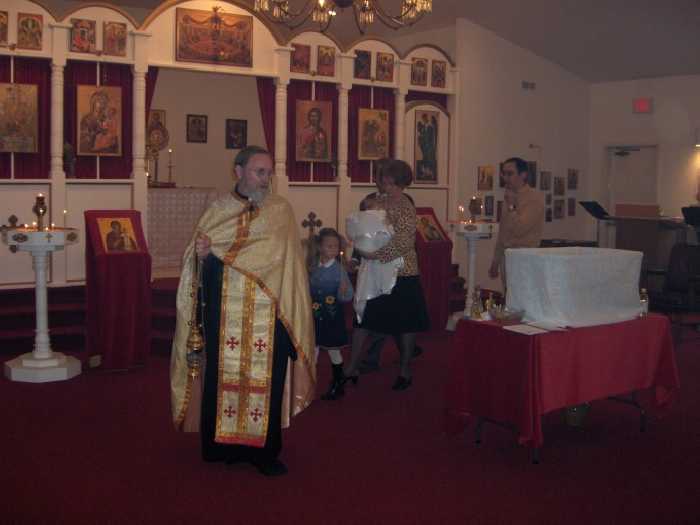 |
| |
|
|
| The mother (Victoria) holds the new born. The father (Yuri), the sponsors and the sisters of Sofia are also following the priest. |
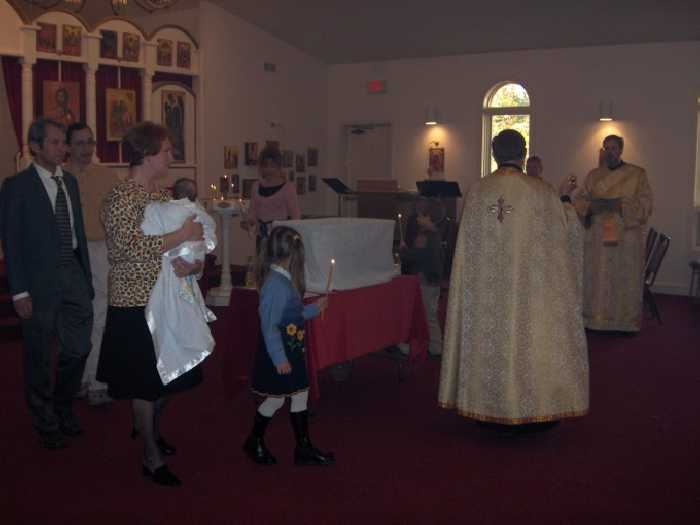 |
| |
|





